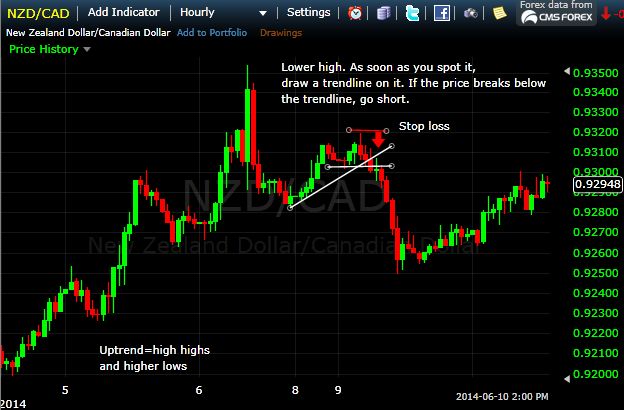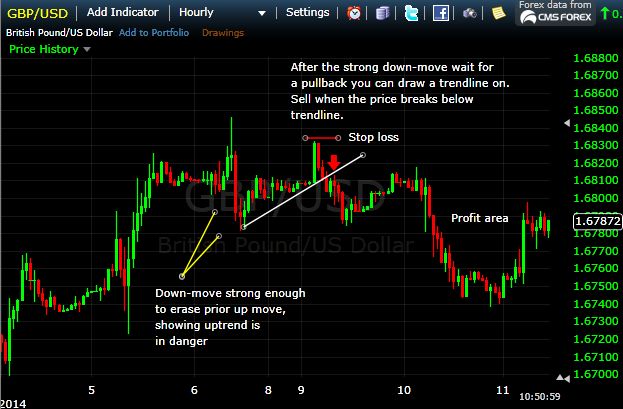Simple Trend Reversal Strategy – Uptrend to Downtrend
In this article we’ll look at uptrend reversals (into downtrends); this is a follow up article to Simple Trend Reversals Strategy – Downtrend to Uptrend, which looked at downtrend reversals.
Trading in the middle of a trend is fine, but trading near a reversal provides a way to jump in on moves as momentum is building. This often provides a high probability trade because those who were betting on the old trend continuing are forced out of their positions, resulting in a surge in the new trending direction. Of course no method of trading works all the time, but trading reversals can be profitable….if you know what to look for.
Uptrend Reversals
An uptrend is in place when the price is making higher swing highs and higher swing lows. Which highs and lows you focus on will be determined by your trading style. Very short term traders may focus on every high and low, which will make for lots of trades. Traders looking to trade less will only focus on major high and low points in the price, and use those points for analysis and trading (see: Only Looking at One Time Frame? Your Likely Missing Something).
Uptrends are reversed by either the price making a new low (lower low) followed by a lower high, or a lower high followed by another decline.
Here is an example of an uptrend being reversed via a lower high.

In the chart above the price is moving in an overall uptrend on the left; higher overall highs and higher overall lows.
The price makes a lower high on the 8/9th than it did on the 6th. As soon as we see that lower high we draw a trendline on the price wave that created that created that lower high. In this case I have drawn two trendlines: one for the actual pullback, and then one along the bottom of the consolidation which occurred at the top of the pullback. When the price drops below either of these lines (usually just one trendline) we sell. The lower high followed by another move lower (below the trendline) provides us with a signal that the uptrend is at minimum in trouble, and could reverse.
If trading traditional markets place a stop loss above the recent high. The trade can be short-term to just catch initial upside momentum, or longer-term to capture the potential bigger trend reversal (should it arise).
The other type of reversal we can have is when the price falls aggressively enough to erase the former wave of the uptrend; a lower low is created. Following the lower low, wait for a pullback you can draw a trendline on. Assuming the price makes a lower high (lower than the major high which started the aggressive decline), sell when the price breaks below the pullback trendline. If trading traditional markets, place a stop above the recent high.

The trade can be short-term to catch initial upside momentum, or longer-term to capture the potential bigger trend reversal (should it arise).
Final Word
These are simple ways to trade uptrend reversals based solely on price action. The method requires that a trendline be drawn on a pullback. If the pullback is very small or very sharp a trendline can’t be drawn, and therefore no signal will be provided. Therefore the method won’t be tradable on every reversal.
Not every signal will result in a reversal, the former trend could resume at any time. This means we need to constantly analyze price action to see when signals in the opposite direction occur.
A profitable exit will depend on whether you want a short-term or longer-term trade. For a short-term trade look to exit within a few bars of the entry bar; you just want to capture the initial momentum. For a longer-term trade you will need to give the market enough time to begin trending in your direction before considering for an exit.